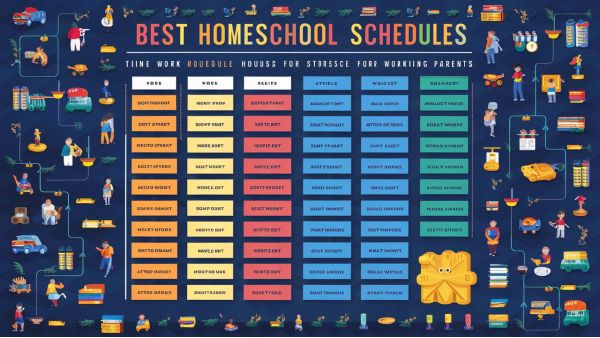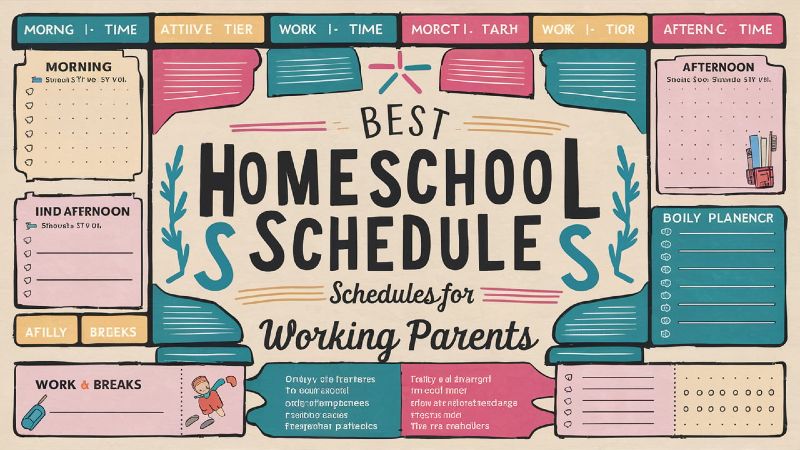Working full time and homeschooling is becoming a trend. Parents desire to have a better education at home. It is not easy to hear. However, when one has a good schedule, it is simpler to keep both sides. The major thing is planning and regularity. How can working moms and dads cope with homeschooling without melting down? Let us see below.
The Case of Homeschooling that Working Parents should Choose
A significant number of families decide to homeschool on the basis that they wold like to determine what their children learn. There are those who fear the school setting. Others like routines that are not binding. Homeschooling provides both. It assists busy parents to have time with kids. It also enables lessons that aren’t necessarily in line with the learning pace of the child. Working moms and dads cannot put a price on this freedom.
Advance your career with must-have skills and explore AI in education. Try live tutoring platforms, manage homeschooling multiple kids, and find affordable homeschool curriculums. Explore more at Study.com.
Priorities First
Start with your best objectives. Which is more important to you? Is it teaching basics or developing soft skills. Other parents desire good mathematics abilities. Other people are into reading or science. By knowing what you want, you can plan what you do daily and weekly. This spares you the feeling of overwhelm. It keeps you in the right track on a daily basis.
Interpretation of Work Hours
Monitor your job changes. Know your availability and free time. You can homeschool in the afternoon when you go to work in the morning. In case you work at night, mornings would be the best option. Go to weekends when you have no time on weekdays. Your most powerful instrument is flexibility. This facilitates scheduling because you are aware of your availability.
A Weekly Schedule Template should be created
You should have a pattern of your week. Keep some kind of digital calendar or a printable schedule. Schedule work calls and breaks. Schedule in concrete hours of homeschooling. This outline helps you to stick to the course. Children love consistency. It also makes them take the learning seriously. Set aside some time to play as well. Breaks enhance concentration.

Sample Homeschool Schedules for Working Parents
Here are some example schedules. Choose the one that fits your work life.
Schedule for Parents Working 9 to 5
Morning: 7:00 to 8:00 – Breakfast and light review
Evening: 6:00 to 8:00 – Main homeschool subjects
Weekend: Field trips or science projects
Schedule for Night Shift Workers
Morning: 9:00 to 11:00 – Core subjects
Afternoon: 3:00 to 4:00 – Reading and creative time
Evening: Rest and family dinner
Split Day Schedule
Morning: 8:00 to 10:00 – Math and language arts
Afternoon: 1:00 to 3:00 – Science and history
Evening: Review or fun activities
Planning for Multiple Children
When you have more than one child to homeschool, you have to think smart. Give older children their own activities. Pay attention to younger ones. Rotate subjects. Put children in groups whenever possible. Apply various levels within a topic. The depth should be age-wise. This does not waste time and ensures that every person is a learner. Advance planning diminishes stress in the daily life.
Overbuilding in Flex Days
At least one flex day should be provided every week. Use it to make up or sleep on. Life happens. Bad days and work days are ordinary. Flex days prevent you to lag behind. They also relieve your child. Learning remains enjoyable without being strenuous. The power of being flexible.
Hints on Being Prolific
Time it. Break it into 30 minutes to 1 hour blocks. Just do one thing at that time. Remove distractions. Put the phone in another room. Learn in a single space. This ensures parent and child focus. Provide rewards to the child and yourself after activities. It aids in maintaining energy levels.
Take advantage of Technology
There are complete lesson plans online. Science experiments using YouTube. Put Google Classroom to the test. There are numerous free tools. Organize tutor video calls whenever necessary. Math and reading apps. This keeps children occupied. It also takes away time spent by parents.
Task Combat Tasks Combine Whenever Possible
Educate during housework. Read a story at breakfast. Math during cooking. Make grocery shopping educational. Such moments are natural learning moments. They relieve stress. You can accomplish a lot within a short period. It also teaches children that education is all around.
Seek and Delegate
You are not obliged to do all things. Get your spouse or your older child to assist. Reading can be monitored by grandparents. Become a part of a local homeschool association. Trade with other parents. Such collaboration simplifies life. It creates solidarity and friendship.
Maintain a Healthy Mental Condition
Homeschooling and working are not a walk in the park. Tend to your welfare. Sleep well. Eat right. Take breaks. Request help. Walk at least once a day. Consult a friend. You also count. You teach better when you feel better. Your child models after your energy.
Dynamic Curriculum Choices
Select curriculum that allows planning of pace. There are open-and-go curriculums. Others require more preparation time. Combine them half and half. Select something that does not conflict with your time. Check reviews. Check out InstituteInfo https://instituteinfo.site/ and view their comparison of the curriculum. Time-wise, be smart.
Monitor Effects Frequently
Note down whatever your child learns. Keep checklists or even stuff notes. Be happy about small wins. Demonstrate to your child his/her progress. This gives them confidence. It also causes you to get a view of what is working and what is not. Write your schedule.
Stay Social
Organize group activities or time to play on the internet. Engage in sports and clubs as a way of socializing. Children should communicate and exchange. It makes them develop emotionally. Even virtual clubs are effective. Books are not the only way of learning. It is also about life. Social time should be made a weekly affair.
Weekend Learning Opportunities
Spend your weekends in more ways than resting on weekends. Make arrangements to go hiking or visit a museum. Learn science by looking at nature around us. Measure until they bake together. Make family history tours. Each trip should be an education. Learning on weekends is enjoyable and dense. It also unites the family. Curious minds never cease learning.
Setting a Special Learning Place
Create a small area that will be used especially to learn. Have supplies convenient. Employ a table or desk. Mark it with instructive diagrams. Do not fill it with toys and noise. A dedicated area creates dedicated brains. Make it pleasant and amiable. This demonstrates to children that learning is something special.
Adjusting to life changes
Times will alternate as your job or life does. Do not panic though. Revise monthly and revise. Remain truthful with what is performing. Go incrementally. A fifteen-minute change is beneficial as well. Children adapt fast as long as you are consistent. Laxity is not synonymous with flexibility. It is intelligent prioritizing.
Encouraging Self-Learning
Teach your children to be self teachers. Send easy directions and forget. See them out. Appreciate their hard work. Gradually have them work more on their own. This creates self-reliance. It gets you time in working. Self-learners perform well anywhere.
Partying like it is the End of the World
Complete a chapter. Celebrate. Finish a project. Celebrate again. Build a wall of accomplishment. Employ stickers or certificates. Parse it. This creates the desire and happiness. Children feel proud of their development. Little parties give rise to great confidence. It makes the experience of homeschooling memorable.
Using Wise Screen Time
Screens are helpful, but should be controlled. Permanent hours on the screen. First, use them to learn. Make breaks screen-free. Promote physical activities. Use a screen time as a reward system. Monitor content. Talk about what they see. The aim is balance. Good screen lives encourage positive minds.
Taking a Monthly Reviewing System
Discuss your plan monthly. Sit with your child. Speak about what they did or did not like. See what succeeded and what did not. Update goals. Schedule new events. This review does not get old. It also engages your child. An expanding plan produces expanding minds.
Teaching Life Skills
Teach human real skills. Budgeting. Time management. Cooking. Cleaning. Even sewing. These work as much as the schoolwork. Teach these with the help of everyday life. Get your child involved. Have them devise a meal. Keep a list of chores. Self-confidence is developed through life skills. They make your child ready to be an adult.
Educational Subscriptions Usage
Take a monthly book box or science kits. These make learning exciting. Children enjoy receiving mail. It is rewarding. Select age based subscriptions. Put them in your array. These instruments enhance practical learning. They will infuse new spirit into your home schooling proposal.

Boost your learning with these free online platforms with certificates and learn coding at home step by step. Improve study habits using note-taking strategies and memorization techniques.
Pros and Cons Table
| Pros | Cons |
|---|---|
| Flexible hours for learning | Time management is tough |
| Stronger parent-child bond | Can be exhausting |
| Custom learning plans | Needs careful planning |
| Safe learning environment | May lack social exposure |
| Affordable in many cases | Hard to balance work |
List for Daily Routine
- Wake up and breakfast
- Quick review of past lessons
- Focus on core subjects
- Take short break
- Creative activity or reading
- Lunch and rest
- Outdoor time or chore-based learning
- Light study or games
- Review day with child
- Prepare for next day
List of Helpful Tools
- Google Classroom
- Khan Academy
- Time4Learning
- Canva for Education
- Trello for scheduling
- Outschool classes
- Storyline Online
- Easy Peasy Homeschool
FAQs
Q1. Is it possible to be a full time worker and still homeschool?
You can. You will require a responsive strategy and intelligent precedents. Small lessons each day are beneficial too.
Q2. How long should I homeschool per day?
Most children require two to four hours. Do not squander time.
Q3. But what happens when my child lags behind?
Ne thin. Change the rhythm. It is about the comprehension rather than the pace. Progress matters.
Q4. Are there homeschool work support groups?
There are indeed numerous online and local groups. They provide guidance and information.
Q5. What would I do to make homeschooling playful to my children?
Add games. Examples are art and music. Have field trips and walks in the nature. Make it thrilling.
Final Thoughts
Working and homeschooling can be balanced through proper means. Place emphasis on balance. Integrate learning into life. Apply flexible time and web-based tools. Ask when in need. Change and make better. It is not an ideal journey but rewarding. Today your child will appreciate the effort you put in.

